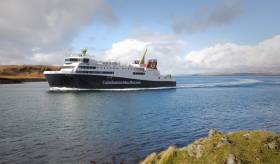Displaying items by tag: Vote Ferry Name
Cast Your Vote: Name New Scottish Arran Dual-Fuel Ferry
#VoteFerryName - A public vote is underway to name the first of a pair of Scottish newbuilds for operator Caledonian MacBrayne. The 102m dual-fuel ferries are to serve Arran on the Forth of Clyde and south-west Scotland, writes Jehan Ashmore.
The pair costing £97m are currently under construction on the Clyde, are designed to provide a fully flexible year-round service for Arran and the Uig Triangle. This is subject to a final review by CalMac Ferries Ltd, Caledonian Maritime Assets Limited (CMAL) and Transport Scotland.
The first of the liquefied natural gas (LNG) and marine diesel fuelled ferries is expected to enter service in early 2018, with the sister following a few months later. Each ferry will carry 127 cars or 16 HGVs or a combination of both and up to 1,000 passengers. In terms of appearance the newbuilds like their existing counterparts will feature twin funnels, see related report.
On introduction they are to replace the oldest of CalMac’s larger ferries, Isle of Arran (see Afloat’s ferry voyage report) and regular island-serving ferry, Caledonian Isles. These ferries will be cascaded throughout the extensive network of 20 routes serving the Inner and Outer Hebrides, a region stretching some 200 miles from Arran to Lewis, makes CalMac the largest ferry operator in the UK.
Among the 32 strong fleet is the ‘Island’ class Canna, albeit on charter from CMAL to Rathlin Ferry Co. The ageing ferry dating to 1976 is soon to be replaced by newbuild Spirit of Rathlin.
Vote from the Shortlist
A shortlist has been selected by the (CMAL) Board and the Scottish Government with help from the Clyde River Steamer Club to reflect the ferry’s Scottish roots. The ferry, currently known as Hull 801, is earmarked for Arran and all names are inspired by the island history and geography.
Shortlisted names for the new ferry are:
Glen Sannox – one of three spectacular valleys on the island, but also the name of the first purpose-built car ferry that serviced the Isle of Arran
Goatfell – the highest point on Arran. On a clear day visitors can see as far as Ireland from its summit Hutton – the name of famous geologist, James Hutton who discovered his theory on the Isle of Arran
Glen Iorsa – the largest valley on the Isle of Arran; steeped in history and a great example of landscape shaped by glaciers
The naming competition (open also to those outside Scotland) was launched recently. To vote in the competition simply go online here and vote for your preferred choice before midnight on Monday 29th May 2017, when voting closes.
The name with the most public votes will be the name of the first LNG ferry.
All of those who voted for the winning name will be entered into a prize draw. One person chosen at random will be invited as a special guest (with a friend) to the launch of the ferry at Ferguson Marine Engineering Limited’s (FMEL) ship yard in Port Glasgow.
The winner will also receive a £200 gift voucher for the Auchrannie Resort, two bottles of commemorative whisky, bottled by Arran Distillery to mark this special occasion, and a special goody bag. Terms and conditions apply.
Please share this with colleagues, friends and family and encourage them to get involved and vote for their favourite name.
To find out more about the 102m dual fuel ferries project visit here.
























































